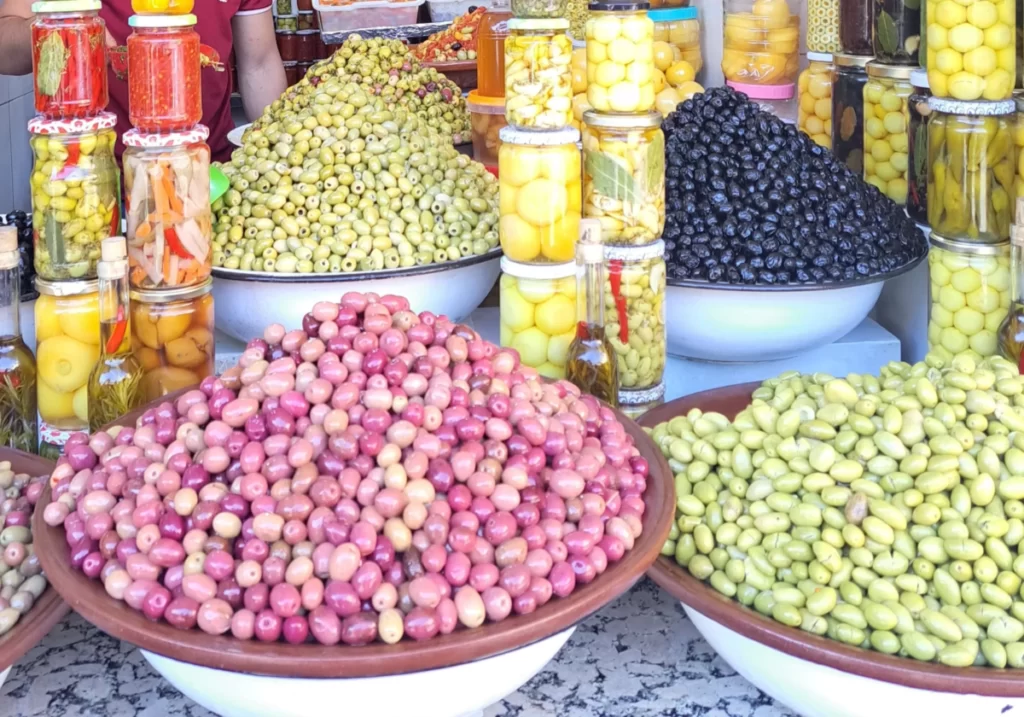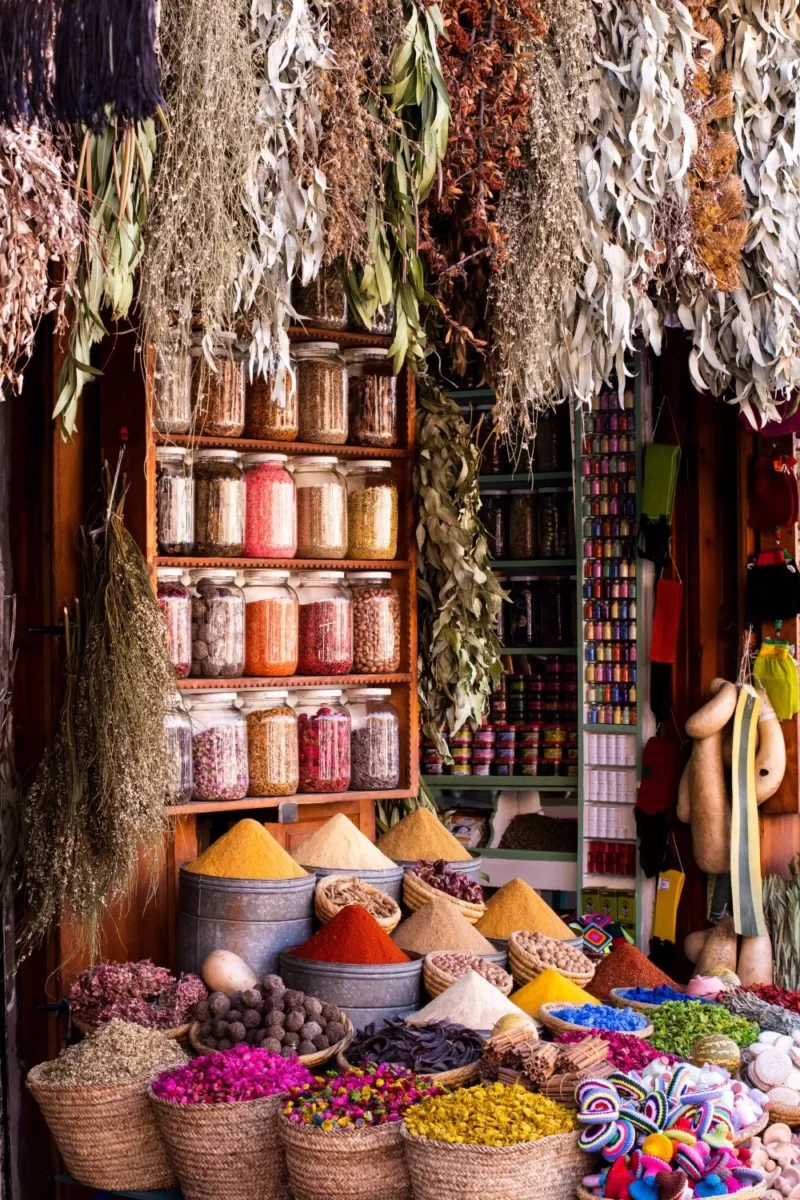Essential Moroccan Spices and Flavourings
Moroccan cuisine is renowned for its outstanding flavour and variety. Combination of freshest ingredients, Moroccan spices, and carefully balanced cooking techniques, help contribute to create mouth-watering dishes that are staples of Moroccan culture. Not to mention, Moroccan food delivery services have made it increasingly easier and more convenient to order food online, or even spices to create your own food, from the comfort of your home with just a few clicks.
Moroccans are meticulous when preparing traditional dishes, choosing only fresh, high-quality ingredients, including freshly ground spices, focussing on the special qualities that each ingredient contributes and carefully avoid those of lesser quality, as these can give the final dish a less than desirable taste. This cuisine is known for the use of a variety of vegetables, as well as herbs, olive oil, argan oil, honey, dried fruits, and nuts. These elements add interesting taste profiles to traditional dishes, such as tagines, couscous, soups, pies, and side dishes.
The right amount and right combination of seasoning is crucial to creating a well-balanced dish, from mild cumin to complex Ras El Hanout. Traditional cooking methods are also essential: from the gentle heat of a tagine that helps redistribute flavours throughout a dish, to grilled kebab creating dishes with tantalizing textures and smells. This knowledge allows for dishes to perfectly balance sweet, savoury, and sour producing exciting dishes.

Ras El Hanout
Ras El Hanout one of the most popular spice blends, it is the cornerstone of many Moroccan dishes. Ras El Hanout literally means “head of the shop” and typically includes a combination of more than thirty different spices in varied proportions, the common ingredients include cumin, cardamom, paprika, nutmeg, black pepper, peppercorn, chili, cinnamon, fenugreek, and other spices. It is used in many traditional dishes like Mrozia, and Rfissa for a very distinctive palate.
Saffron
Saffron is known as “Red Gold,” it is the most expensive spice in the world. While harvested in only a few regions throughout Morocco, it can be found in the various spice markets in the country. Two well-known sites for their premier quality production are Taliouine, a mountain village in the south of the Moroccan kingdom, and the Ourika Valley near Marrakech.
At the start of the day, majestic purple crocuses greet the diligent women as they set out to collect the delicate, fragile red stigmas of the flower—picked out by hand. As there are only three thread-like stigmas per flower, it takes a great effort to achieve the harvest of one kilogram. Despite its laborious process, saffron is widely used for its bright yellow hue and unique blend of flavours, combining sweetness of honey with the subtle grassiness.
it is used in traditional dishes such as Tajine and couscous. It also can be found in desserts, marinades, and beverages. Additionally, people use it to create healthy, skin care and remedies, and for fabric dye. Overall, saffron has been a staple in Morocco’s rich culture and history for thousands of years, and it continues to shape their culinary art and enrich their lifestyle today.
Cinnamon
Cinnamon is another spice used in many Moroccan dishes. Either ground or in the form of sticks, it is used in both sweet and savoury dishes like pastilla pie, Mhancha, Jawhara, Seffa and caramelized tagines as well as bakes and spiced coffee, to add warmth and a sweet and woody note.
Cumin
Cumin is an important spice often used in Moroccan dishes. This warm and aromatic spice has a very distinct flavour and is used in stews, side dishes, and omelettes. The spice is typically added near the end of the cooking process, since over cooking can cause bitterness to the food.
Cumin is also served with grilled Kebab along with salt, often with dry chili for added spiciness.
It is known for its ability to aid digestion and reduce flatulence. Additionally, cumin contains flavonoids, compounds that act as antioxidants in the body, neutralizing free radicals which can damage cells and lead to illnesses.
Ginger
It is an important ingredient in this cuisine, especially when it comes to chicken seasoning and marinade, giving dishes a distinctive tanginess. It is also believed to provide some health benefits, particularly its anti-inflammatory and antiviral properties.
Black Pepper
Black pepper is a versatile spice that is used widely in traditional Moroccan cooking. It is bold and earthy, with a hint of heat. It is often used to season almost all tajines and couscous. It is also sometimes sprinkled on dishes as a finishing touch or as part of a salad garnish. Black pepper pairs exceptionally well with a variety of other spices, such as ginger, turmeric, and garlic.
Orange blossom water
Orange blossom is a fragrant and sweet water distilled from orange blossoms. It is used in many Moroccan desserts and pastries, giving them a delicate aroma. It can also be used in savoury dishes to infuse the dish with a subtle citrus flavour.
Honey
Morocco is renowned for its high-quality honey which has a long history of production and consumption. Honey is an integral part of the traditional cuisine of the country, included in many desserts such as Briwat, or Chebakina, a sesame cookie which is usually eaten during the month of Ramadan with Harira soup. It is also used to sweeten tea, coffee, and other pastries like pancakes, Baghrir, Melawi and Mesamen. But it is not only a sweetener – it is also used in various traditional Moroccan dishes, adding sweetness to Mrozia, Lamb Tagine, and Amlou, the traditional almond and argan spread.
In addition to being a key ingredient in Moroccan food, honey has long been used in traditional Moroccan medicine for a range of remedies. These include coughs, headaches, stomach-aches, and skin rashes. It is also believed to improve digestion and enhance immunity.
The world’s largest traditional bee yard at Morocco’s Inzerki collective apiary stands around 1000 meters tall and is made up of mud, wood, palms, and hay. It is owned by local beekeepers who use traditional beekeeping practices.
Moroccan honey is distinguished not only for its fragrance but also for its variety. The country’s mild climate and diverse vegetation provides an ideal environment for beekeeping, and Moroccans have a long tradition of rearing bees. Morocco’s large selection of mountains, valleys, plateaus, and deserts create a diverse range of flowers and plants with which bees harvest their honey in many different areas with a delicious aroma. Each region also has different types of honey such as thyme, orange blossom, wild flowers, acacia, eucalyptus, argan and pine.
Roses
Whenever I come across roses, I am always reminded of my time back home in Morocco. whether arranged in a beautiful bouquet, used as a garnish in both bakes and dishes, or made into rosewater.
Additionally, Moroccans welcome their guests with a small rose water sprinkler with floral water or perfume. Interestingly, even the water fountains found in the heart of the authentic Moroccan riads were decorated with rose petals providing an alluring romantic ambience.
Every spring, tourists, and locals head to Kelaat-M’Gouna, also known as the valley of roses, for its annual rose festival. This vibrant explosion of colour and aroma brings along visitors to a selection of activities, with the main event normally being the coronation of the Rose Queen, followed by a parade of float embellished with roses. During this time, traders offer different handcrafted rose products such as perfumes, essential oils, soaps, dried roses and rose water for purchase and people can indulge themselves with delicious Amazigh food and participate in the lively music and dancing.
Mastic
Mastic is a hardened resin coming from the mastic tree, not to be confused with Arabic gum. Mastic is often used to add interest to many desserts, such as Sellou, almond Briouat, and almond cigars, etc. It adds a unique touch of pine and lemon which is why it is a must-have in Moroccan cuisine. It enhances the overall taste of any pastry and is a crucial part of the local culinary tradition. Mastic has a gum-like texture with a bubble-gum flavor, and is rich in antioxidants.
Preserved lemons
Preserved lemons are a must-have for a traditional Moroccan pantry. They give depth to many dishes. The unique tanginess of preserved lemons is key element in the preparation of chicken tagine, and other main dishes and sides, which helps create a mouth-watering dish that cannot be achieved with any other ingredient.
Pickled olives
Pickled olives are also a popular ingredient in Morocco. They are traditionally used in tagines, and as an accompaniment to other dishes, and can also be eaten with bread for breakfasts. Rich in healthy fats, olives provide essential vitamins and minerals, making them an important part of Moroccan cooking.
Olive oil
Olive oil is a key ingredient to Moroccan cooking. Not only is it used for cooking, but it is also added to dressings, salads, and dips to provide fruity notes and nutritional benefits. Olive oil is preferred for its high quality and low acidity.
Argan oil
Argan trees grow only in Morocco, argan oil is used in cooking, sometimes used in traditional spreads such as “Amlou,” a butter-like paste like peanut butter. It is also widely used in cosmetics due to its nourishing and protective properties.
Chermoula
Chermoula is Morocco’s popular marinade, made of fresh coriander, parsley, garlic, lemon, olive oil, and spices. It is mostly used to marinate fish and seafood before cooking, but it can also be used as a dip or sauce for accompaniments.
Traditionally, chermoula is made using a pestle and mortar to mix into a thick texture, but modern versions generally use a blender to create a fine paste.
Traditionally, it was created by pounding the ingredients with a pestle and mortar, to create a thick paste.
Harissa
Harissa is a chili paste made up of red chili, garlic, lemon, herbs, and spices. It is usually used to add a robust sharpness to a variety of dishes, especially seafood or served as a condiment alongside a dish. It is widely present in Moroccan cuisine and is said to represent the Moroccan flag, as it is usually found in both red and green colours. It is also popular in other parts of North Africa, particularly in Tunisia.
Almonds
Morocco is unique in the variety of dishes it has which involve the use of almonds. From savoury prune tajine or chicken pastilla to sweet pastries like Briouat (briwat), and cakes, almond adds a subtle nutty texture which balances the complexity of spices used in the cuisine.
Sesame seeds
Sesame seeds provide a nutty taste and crunchy texture to a variety of dishes. They are usually toasted in a wood-fired grill to bring out their nutty taste, and can be sprinkled over salads, tagines, breads and used in cookies, Sellou and Chebakia.
Mint
Mint is not only a popular ingredient in Moroccan tea, but it is also used to enhance the aroma of soups and salads with its refreshing taste.
In addition to mint, other herbs commonly used to brew tea include absinthe, sage, camomile, verbena, thyme, rose, and saffron.
Herbs
In addition to Moroccan spices, a variety of aromatic herbs including bay leaves, thyme, parsley, rosemary, coriander, celery, basil, oregano, and fennel, are integral components of Moroccan culture. These herbs are added to the dishes to add flavour, but they are also thought to have a health benefit. Many of these herbs have anti-inflammatory and antiviral properties, which make them beneficial for wellness purposes.
Whether you are looking for Moroccan spices, a convenient and healthy meal delivery service, or authentic takeaway from a nearby Moroccan restaurant, you can be sure to find a delicious option that fits your needs. You can order food online from a variety of convenient digital Moroccan restaurants that offer meal delivery to your home, opt for a dine-in experience, or even order spices and experiment with cooking your own Moroccan food.


Its very nice to learn Morocco spice and food as well culture keep going.
Thank you Shokat.